Lights Over lapland is excited to announce that Autumn Aurora Adventures are available for immediate booking! Reserve your adventure of a lifetime in Abisko National Park, Sweden today! | | |
WE ARE INSIDE A SOLAR WIND STREAM: For the 3rd day in a row, Earth is inside a stream of solar wind flowing from a hole in the sun's atmosphere. The steady pressure of this stream on our planet's magnetic field sparked a minor geomagnetic storm on July 22nd, but so far no bright auroras. We should begin to exit the stream on July 24th. Free: Aurora Alerts
MASSIVE EXPLOSION ON THE FARSIDE OF THE SUN: Earlier today, July 23rd, a spectacular CME emerged from the farside of the sun. Coronagraphs onboard the orbiting Solar and Heliospheric Observatory (SOHO) tracked the fast-moving cloud as it billowed into space:
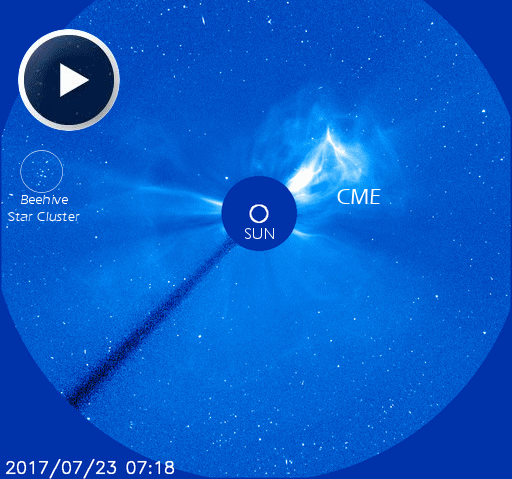
NASA's STEREO-A spacecraft, which has a partial view of the sun's farside, identified the source of the blast as active sunspot AR2665, familiar to readers of Spaceweather.com who watched the behemoth cross the Earthside of the sun earlier this month. STEREO-A observed an intense flash of extreme UV radiation from the sunspot's magnetic canopy:

The intensity of the flash suggests (but does not prove) that the underlying flare might have been the most intense kind: X-class.
If this explosion had occurred 2 weeks ago when the huge sunspot was facing Earth, we would be predicting strong geomagnetic storms in the days ahead. Instead, the CME is racing away from our planet ... and directly toward Mars. Compared to Earth, the Red Planet is currently on the opposite side of the sun, and apparently in the crosshairs of this CME. Mars rovers Curiosity and Opportunity might be observing the effects of a solar storm later this week.
Coincidentally, today's farside explosion occurred on the 5th anniversary of another significant farside event: The Solar Superstorm of July 23, 2012. That superstorm, which has been compared to the historic Carrington Event of 1859, could have caused widespread power blackouts if it had not missed our planet.
Sunspot AR2665 will be back on the Earthside of the sun starting little more than a week from now. If the sunspot remains active, it could bring a new round of geomagnetic storms and auroras to our planet in early August. Stay tuned. Free: Solar Flare Alerts
Realtime Space Weather Photo Gallery
SPRITES AND COSMIC RAYS: On Friday night, cameras in Czechia recorded a magnificent display of sprites leaping up from a thunderstorm in neighboring Austria. Photographer Martin Popek of Nýdek, Czechia, selected this specimen from many frames he recorded:
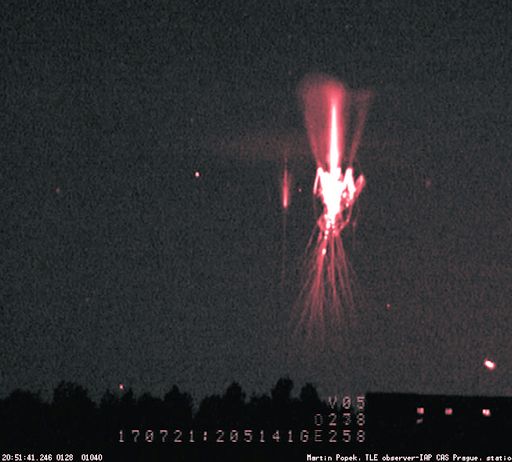
"The storm was about 390km away," says Popek, "and the sprite was huge. It stretched 50 km to 90 km above the ground below."
Sometimes called "space lightning," sprites are a true space weather phenomenon. They inhabit the upper atmosphere alongside auroras, meteors and noctilucent clouds. Some researchers believe they are linked to cosmic rays: subatomic particles from deep space striking the top of Earth's atmosphere produce secondary electrons that, in turn, could provide the spark that triggers sprites.
The link to cosmic rays is particularly interesting at this time. Despite a brief reduction in cosmic rays last week caused by the sweeping action of a passing CME, cosmic rays are intensifying. For the past two years, space weather balloons have observed a steady increase in deep space radiation penetrating our atmosphere. This increase is largely due to the decline of the solar cycle. Flagging solar wind pressure and weakening sunspot magnetic fields allow more cosmic rays into the inner solar system--a trend which is expected to continue for years to come. These changes could add up to more sprites.
Although sprites have been seen for at least a century, most scientists did not believe they existed until after 1989 when sprites were photographed by cameras onboard the space shuttle. Now "sprite chasers" routinely photograph sprites from their own homes. "I used up a Watec 910HX security camera with UFOCapture software to catch my sprites," says Popek. Give it a try!
Realtime Sprite Photo Gallery
SOLAR ECLIPSE SPACE PENDANTS: Would you like to support our Solar Eclipse Balloon Network? Here's one way: Buy a space pendant. This solar eclipse-themed necklace flew to the stratosphere on July 2, 2017, attached to the payload of an Earth to Sky Calculus space weather balloon:
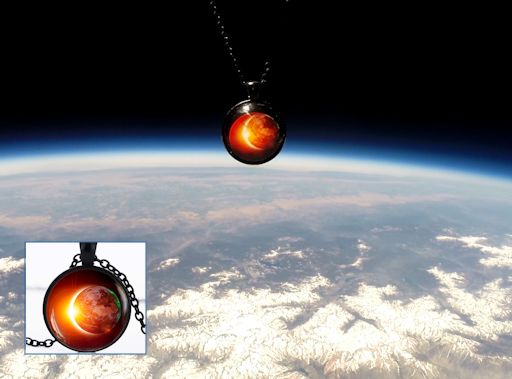
The payload contained more just like it. If you buy one now for $79.95, we will fly it back to the stratosphere during the Great American Solar Eclipse on August 21, 2017, where it will be enveloped by the Moon's cool shadow above our launch site in Oregon. No additional charge! Just make a note in the COMMENTS BOX of the shopping cart: "Please fly my pendant into the eclipse!" Each pendant comes with a greeting card showing the jewelry in flight and telling the story of its journey to the stratosphere and back again.
More items from the edge of space may be found in the Earth to Sky Store. All proceeds support atmospheric radiation monitoring and hands-on STEM education.
Far Out Gifts: Earth to Sky Store
All proceeds support hands-on STEM education
CME SWEEPS ASIDE COSMIC RAYS: On July 16th, a CME hit Earth's magnetic field, sparking two days of geomagnetic storms and beautiful southern auroras. The solar storm cloud also swept aside some of the cosmic rays currently surrounding Earth. Spaceweather.com and the students of Earth to Sky Calculus launched a space weather balloon to the stratosphere hours after the CME arrived. We detected a 7% decrease in X-rays and gamma-rays (two tracers of secondary cosmic rays). Neutron monitors in the Arctic and Antarctic recorded similar decrements. For instance, these data from the Bartol Research Institute show a nearly 8% drop in cosmic ray neutrons reaching the South Pole:
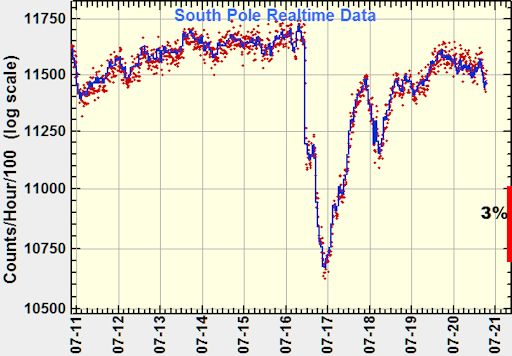
This is called a "Forbush Decrease," named after physicist Scott E. Forbush who first described it in the 20th century. Wherever CMEs go, cosmic rays are deflected by magnetic fields inside the solar storm clouds. As a result, when solar activity is high, cosmic radiation around Earth is relatively low--a yin-yang relationship that holds throughout all phases of the solar cycle.
Lately, cosmic rays around Earth have been intensifying as the solar cycle plunges toward minimum. The CME of July 16th reversed that trend--but only for a few days. Solar activity has returned to low levels and cosmic rays are on the rise again.
Why do we care about cosmic rays? For one thing, they penetrate commercial airlines, dosing passengers and flight crews so much that pilots are classified as occupational radiation workers. Some research shows that cosmic rays can seed clouds and trigger lightning, potentially altering weather and climate. Furthermore, there are studies ( #1, #2, #3, #4) linking cosmic rays with cardiac arrhythmias in the general population.
Realtime Space Weather Photo Gallery
Realtime Noctilucent Cloud Photo Gallery
Realtime Aurora Photo Gallery
Every night, a network of
NASA all-sky cameras scans the skies above the United States for meteoritic fireballs. Automated software maintained by NASA's Meteoroid Environment Office calculates their orbits, velocity, penetration depth in Earth's atmosphere and many other characteristics. Daily results are presented here on Spaceweather.com.
On Jul. 23, 2017, the network reported 5 fireballs.
(5 sporadics)

In this diagram of the inner solar system, all of the fireball orbits intersect at a single point--Earth. The orbits are color-coded by velocity, from slow (red) to fast (blue). [Larger image] [movies]
Potentially Hazardous Asteroids (
PHAs) are space rocks larger than approximately 100m that can come closer to Earth than 0.05 AU. None of the known PHAs is on a collision course with our planet, although astronomers are finding
new ones all the time.
On July 23, 2017 there were 1803 potentially hazardous asteroids.
 |
Recent & Upcoming Earth-asteroid encounters: | Asteroid | Date(UT) | Miss Distance | Velocity (km/s) | Diameter (m) |
| 2017 NX5 | 2017-Jul-18 | 10.2 LD | 13.4 | 51 |
| 2017 OH1 | 2017-Jul-19 | 1.6 LD | 17.8 | 14 |
| 2017 OG1 | 2017-Jul-20 | 17.9 LD | 7.9 | 80 |
| 2017 BS5 | 2017-Jul-23 | 3.1 LD | 5.8 | 54 |
| 2017 OE1 | 2017-Jul-25 | 8.7 LD | 17.3 | 45 |
| 2011 CC22 | 2017-Aug-04 | 15.5 LD | 18.4 | 186 |
| 2014 OA339 | 2017-Aug-13 | 12.3 LD | 10 | 47 |
| 3122 | 2017-Sep-01 | 18.5 LD | 13.5 | 5376 |
| 2014 RC | 2017-Sep-11 | 15.1 LD | 8.9 | 16 |
Notes: LD means "Lunar Distance." 1 LD = 384,401 km, the distance between Earth and the Moon. 1 LD also equals 0.00256 AU. MAG is the visual magnitude of the asteroid on the date of closest approach. | | Cosmic Rays in the Atmosphere |
Readers, thank you for your patience while we continue to develop this new section of Spaceweather.com. We've been working to streamline our data reduction, allowing us to post results from balloon flights much more rapidly, and we have developed a new data product, shown here:

This plot displays radiation measurements not only in the stratosphere, but also at aviation altitudes. Dose rates are expessed as multiples of sea level. For instance, we see that boarding a plane that flies at 25,000 feet exposes passengers to dose rates ~10x higher than sea level. At 40,000 feet, the multiplier is closer to 50x. These measurements are made by our usual cosmic ray payload as it passes through aviation altitudes en route to the stratosphere over California.
What is this all about? Approximately once a week, Spaceweather.com and the students of Earth to Sky Calculus fly space weather balloons to the stratosphere over California. These balloons are equipped with radiation sensors that detect cosmic rays, a surprisingly "down to Earth" form of space weather. Cosmic rays can seed clouds, trigger lightning, and penetrate commercial airplanes. Furthermore, there are studies ( #1, #2, #3, #4) linking cosmic rays with cardiac arrhythmias and sudden cardiac death in the general population. Our latest measurements show that cosmic rays are intensifying, with an increase of more than 13% since 2015:
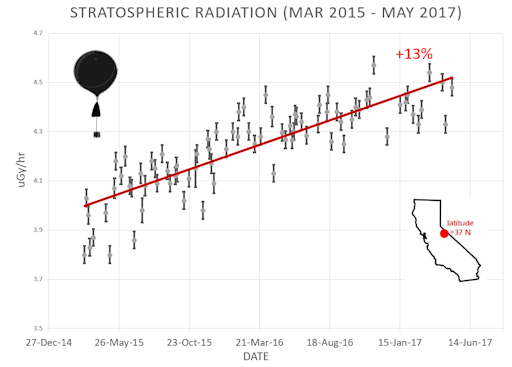
Why are cosmic rays intensifying? The main reason is the sun. Solar storm clouds such as coronal mass ejections (CMEs) sweep aside cosmic rays when they pass by Earth. During Solar Maximum, CMEs are abundant and cosmic rays are held at bay. Now, however, the solar cycle is swinging toward Solar Minimum, allowing cosmic rays to return. Another reason could be the weakening of Earth's magnetic field, which helps protect us from deep-space radiation.
The radiation sensors onboard our helium balloons detect X-rays and gamma-rays in the energy range 10 keV to 20 MeV. These energies span the range of medical X-ray machines and airport security scanners.
The data points in the graph above correspond to the peak of the Reneger-Pfotzer maximum, which lies about 67,000 feet above central California. When cosmic rays crash into Earth's atmosphere, they produce a spray of secondary particles that is most intense at the entrance to the stratosphere. Physicists Eric Reneger and Georg Pfotzer discovered the maximum using balloons in the 1930s and it is what we are measuring today.
| | The official U.S. government space weather bureau |
| | The first place to look for information about sundogs, pillars, rainbows and related phenomena. |
| | Researchers call it a "Hubble for the sun." SDO is the most advanced solar observatory ever. |
| | 3D views of the sun from NASA's Solar and Terrestrial Relations Observatory |
| | Realtime and archival images of the Sun from SOHO. |
| | from the NOAA Space Environment Center |
| | a proud supporter of science education and Spaceweather.com |
| | fun to read, but should be taken with a grain of salt! Forecasts looking ahead more than a few days are often wrong. |
| | from the NOAA Space Environment Center |
| | the underlying science of space weather |
 | Beautyz for top beauty products reviews and their buying guides |
 | Reviews here can help you to pick up best memory foam mattresses. |
| | These links help Spaceweather.com stay online. Thank you to our supporters! |
| | | | | | |

